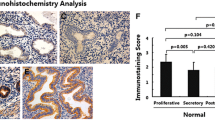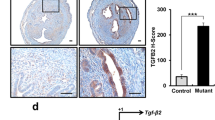Abstract
Purpose
Adenomyosis has been studied throughout the years, however, its aetiology and physiopathology are still unknown. The aim of this study was to identify the presence of PIWI proteins in women with adenomyosis.
Methods
We included 72 participants to be part of this study and were divided into two groups based on their anatomopathological diagnosis, control (n = 36) or adenomyosis (n = 36). All samples were tested for PIWIL1, PIWIL2 and PIWIL4 proteins by immunohistochemistry. The evaluation of protein expression was performed by the digital histological score (DHSCORE) and by the pathologist’s analysis.
Results
The participants had a mean age of 44.28 ± 5.76 years and 45.81 ± 4.86 years in the control and adenomyosis groups, respectively (p ≥ 0.05). Other clinical characteristics of the participants showed no statistical difference as well. PIWIL2 is highly expressed in the adenomyosis in comparison to the control group (p = 0.0001). The PIWIL1 is downregulated in the adenomyosis (p = 0.003) and PIWIL4 showed no difference in its expression (p = 0.05).
Conclusion
PIWIL2 might be involved in cellular survival and PIWIL1 may be downregulated due to the loss of tissue’s function and response to the hostile environment of the myometrium. This is the first time that PIWI proteins are studied in the adenomyosis.





Similar content being viewed by others
Data availability
The datasets used and analysed during the current study are available from the corresponding author on reasonable request.
References
Garavaglia E, Audrey S, Annalisa I, Stefano F, Iacopo T, Laura C et al (2015) Adenomyosis and its impact on women fertility. Iran J Reprod Med 13(6):327–336
Benagiano G, Brosens I, Habiba M (2015) Adenomyosis: a life-cycle approach. Reprod Biomed Online 30(3):220–232
Bergeron C, Amant F, Ferenczy A (2006) Pathology and physiopathology of adenomyosis. Best Pract Res Clin Obstet Gynaecol 20(4):511–521
Benagiano G, Habiba M, Brosens I (2012) The pathophysiology of uterine adenomyosis: an update. Fertil Steril 98(3):572–579
Barrier BF, Malinowski MJ, Dick EJ, Hubbard GB, Bates GW (2004) Adenomyosis in the baboon is associated with primary infertility. Fertil Steril 82(SUPPL. 3):1091–1094
Zhou S, Yi T, Liu R, Bian C, Qi X, He X et al (2012) Proteomics identification of annexin A2 as a key mediator in the metastasis and proangiogenesis of endometrial cells in human adenomyosis. Mol Cell Proteom 11(7):M112 (017988)
Carrarelli P, Yen C-F, Arcuri F, Funghi L, Tosti C, Wang T-H et al (2015) Myostatin, follistatin and activin type II receptors are highly expressed in adenomyosis. Fertil Steril 104(3):744–752.e1
Qiao D, Zeeman A-M, Deng W, Looijenga LHJ, Lin H (2002) Molecular characterization of hiwi, a human member of the piwi gene family whose overexpression is correlated to seminomas. Oncogene 21(25):3988–3999
Yan H, Wu Q-L, Sun C-Y, Ai L-S, Deng J, Zhang L et al (2015) piRNA-823 contributes to tumorigenesis by regulating de novo DNA methylation and angiogenesis in multiple myeloma. Leukemia 29(1):196–206 (15)
Liu W-K, Jiang X-Y, Zhang Z-X (2010) Expression of PSCA, PIWIL1 and TBX2 and its correlation with HPV16 infection in formalin-fixed, paraffin-embedded cervical squamous cell carcinoma specimens. Arch Virol 155(5):657–663
Fuhrich D, Lessey B, Savaris R (2013) Comparison of HSCORE assessment of endometrial beta3 integrin subunit expression with digital HSCORE using computerized image analysis (ImageJ). Anal Quant Cytopathol Histpathol 35(4):210–216
Ferreira HJ, Heyn H, Garcia del Muro X, Vidal A, Larriba S, Munoz C et al (2014) Epigenetic loss of the PIWI/piRNA machinery in human testicular tumorigenesis. Epigenetics 9(1):113–118
Siddiqi S, Matushansky I (2012) Piwis and piwi-interacting RNAs in the epigenetics of cancer. J Cell Biochem 113(2):373–380
Tremellen KP, Russell P (2012) The distribution of immune cells and macrophages in the endometrium of women with recurrent reproductive failure II: adenomyosis and macrophages. J Reprod Immunol 93(1):58–63
Lee JH, Engel W, Nayernia K (2006) Stem cell protein Piwil2 modulates expression of murine spermatogonial stem cell expressed genes. Mol Reprod Dev 73(2):173–179
Wang Q-E, Han C, Milum K, Wani AA (2011) Stem cell protein Piwil2 modulates chromatin modifications upon cisplatin treatment. Mutat Res 708(1–2):59–68
Vannuccini S, Tosti C, Carmona F, Huang SJ, Chapron C, Guo SW et al (2017) Pathogenesis of adenomyosis: an update on molecular mechanisms. Reprod Biomed Online 35(5):592–601
Kitawaki J (2006) Adenomyosis: the pathophysiology of an oestrogen-dependent disease. Best Pract Res Clin Obstet Gynaecol 20(4):493–502
Goumenou A, Panayiotides I, Matalliotakis I, Vlachonikolis I, Tzardi M, Koumantakis E (2001) Bcl-2 and Bax expression in human endometriotic and adenomyotic tissues. Eur J Obstet Gynecol Reprod Biol 99(2):256–260
Lee JH, Schütte D, Wulf G, Füzesi L, Radzun H-J, Schweyer S et al (2006) Stem-cell protein Piwil2 is widely expressed in tumors and inhibits apoptosis through activation of Stat3/Bcl-XL pathway. Hum Mol Genet 15(2):201–211 (15)
Lim SL, Ricciardelli C, Oehler MK, Tan IMDDA, Russell D, Grutzner F (2014) Overexpression of piRNA pathway genes in epithelial ovarian cancer. PLoS ONE 9(6):e99687
Acknowledgements
We would like to acknowledge the UPE from Centro de Pesquisa Experimental from Hospital de Clínicas de Porto Alegre that ensured the viability of the experiments by providing the laboratory’s structure and logistics for it to succeed.
Funding
The Fundação Médica do Rio Grande do Sul, Fundação Incentivo à Pesquisa e Eventos (FIPE) from Hospital de Clínicas de Porto Alegre, CNPq and Coordenação de Aperfeiçoamento de Pessoal de Nível Superior (Capes) funded this study.
Author information
Authors and Affiliations
Contributions
MMCM and JSLCF were responsible for the planning and execution of the project, data collection/analysis, statistical analysis, and draft of the manuscript. VKG and CABS were responsible for data collection, execution of the experiments and draft of the manuscript. PRO was responsible for ethical committee approval, planning of the project and draft of the manuscript. ACPF was responsible for participants’ selection, analysis of the immunohistochemistry results and draft of the manuscript.
Corresponding author
Ethics declarations
Conflict of interests
The authors declare that they have no competing interests.
Consent to participate
All participants signed an informed consent form to be part in the study.
Ethics approval
This study was approved by the Hospital de Clínicas de Porto Alegre’s (HCPA) ethics committee, and it is registered under number 16-0639 and CAAE: 63591516.0.0000.5327 at Plataforma Brasil.
Additional information
Publisher's Note
Springer Nature remains neutral with regard to jurisdictional claims in published maps and institutional affiliations.
Rights and permissions
About this article
Cite this article
Mattia, M.M.C., Fernandes, A.C.P., Genro, V.K. et al. PIWIL2 is overexpressed in adenomyotic lesions of women with diffuse adenomyosis. Arch Gynecol Obstet 302, 925–933 (2020). https://doi.org/10.1007/s00404-020-05660-w
Received:
Accepted:
Published:
Issue Date:
DOI: https://doi.org/10.1007/s00404-020-05660-w




